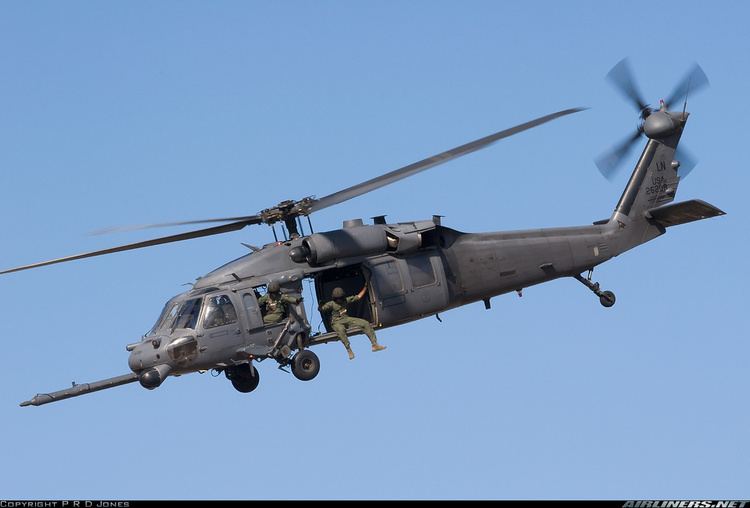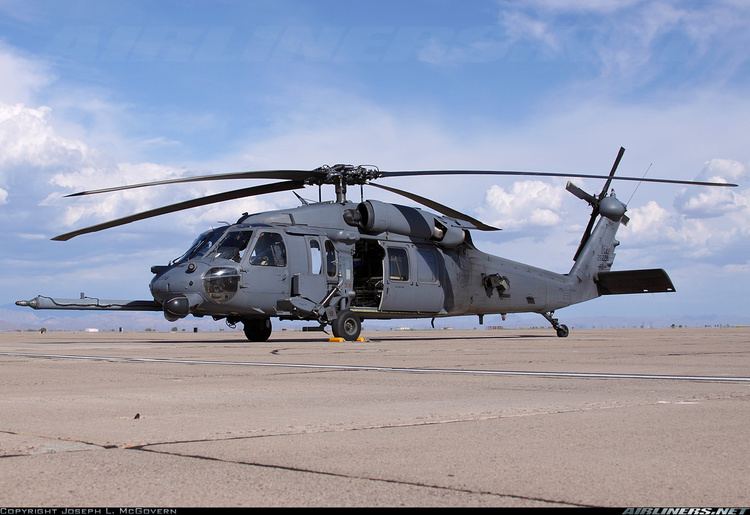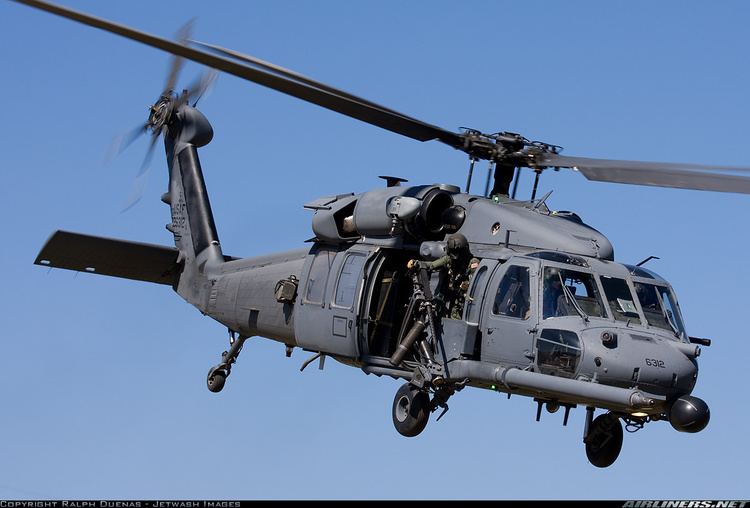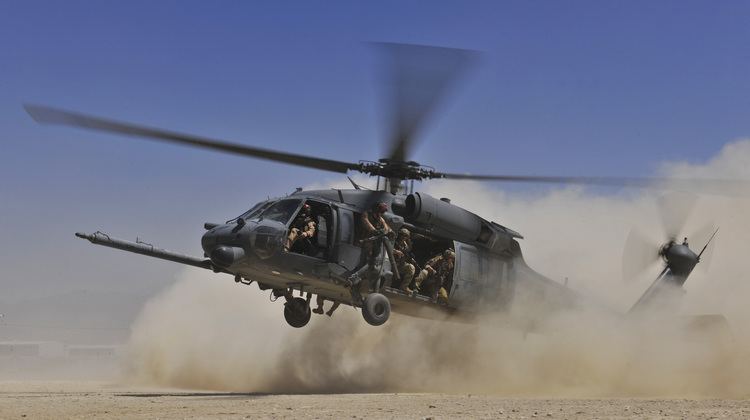Top speed 361 km/h Weight 7,260 kg Cruise speed 294 km/h | Length 20 m Wingspan 14 m Engine type General Electric T700 | |
Unit cost 15,800,000–15,800,000 USD, 33,160,000–33,160,000 USD (2012) | ||
Sikorsky hh 60 pave hawk
The Sikorsky MH-60G/HH-60G Pave Hawk is a twin-turboshaft engine helicopter in service with the United States Air Force. It is a derivative of the UH-60 Black Hawk and incorporates the US Air Force PAVE electronic systems program. The HH-60/MH-60 is a member of the Sikorsky S-70 family.
Contents
- Sikorsky hh 60 pave hawk
- Design and development
- Operational history
- Replacement
- Variants
- Operators
- Specifications HH 60G
- Onboard systems
- References

The MH-60G Pave Hawk's primary mission is insertion and recovery of special operations personnel, while the HH-60G Pave Hawk's core mission is recovery of personnel under stressful conditions, including search and rescue. Both versions conduct day or night operations into hostile environments. Because of its versatility, the HH-60G may also perform peacetime operations such as civil search and rescue, emergency aeromedical evacuation (MEDEVAC), disaster relief, international aid and counter-drug activities.

Sikorsky hh 60 pave hawk
Design and development

In 1981, the U.S. Air Force chose the UH-60A Black Hawk to replace its HH-3E Jolly Green Giant helicopters. After acquiring some UH-60s, the Air Force began upgrading each with an air refueling probe and additional fuel tanks in the cabin. The machine guns were changed from 0.308 in (7.62 mm) M60s to 0.50 in (12.7 mm) XM218s. These helicopters were referred to as "Credible Hawks" and entered service in 1987.

Afterwards, the Credible Hawks and new UH-60As were upgraded and designated MH-60G Pave Hawk. These upgrades were to be done in a two-step process. However, funding allowed only 16 Credible Hawks to receive the second step equipment. These helicopters were allocated to special operations use. The remaining 82 Credible Hawks received the first step upgrade equipment and were used for combat search and rescue. In 1991, these search and rescue Pave Hawks were redesignated HH-60G.

The Pave Hawk is a highly modified version of the Sikorsky UH-60 Black Hawk. It features an upgraded communications and navigation suite that includes an integrated inertial navigation/global positioning/Doppler navigation systems, satellite communications, secure voice, and Have Quick communications. The term PAVE stands for Precision Avionics Vectoring Equipment.
All HH-60Gs have an automatic flight control system, night vision goggles lighting and forward looking infrared system that greatly enhances night low-level operations. Additionally, some Pave Hawks have color weather radar and an engine/rotor blade anti-ice system that gives the HH-60G an all-weather capability. Pave Hawk mission equipment includes a retractable in-flight refueling probe, internal auxiliary fuel tanks, two crew-served (or pilot-controlled) 7.62 mm miniguns or .50-caliber machine guns and an 8,000 pound (3,600 kg) capacity cargo hook. To improve air transportability and shipboard operations, all HH-60Gs have folding rotor blades.
Pave Hawk combat enhancements include a radar warning receiver, infrared jammer and a flare/chaff countermeasure dispensing system. HH-60G rescue equipment includes a hoist capable of lifting a 600-pound (270 kg) load from a hover height of 200 feet (60 m), and a personnel locating system. A number of Pave Hawks are equipped with an over-the-horizon tactical data receiver that is capable of receiving near real-time mission update information.
Operational history
As of 2015, the U.S. Air Force HH-60G Pave Hawk is operated by the Air Combat Command (ACC), U.S. Air Forces in Europe (USAFE), Pacific Air Forces (PACAF), Air Education and Training Command (AETC), the Air Force Reserve Command (AFRC) and the Air National Guard (ANG). A number of HH-60Gs are also operated by the Air Force Material Command (AFMC) for flight test purposes.
During Operation Desert Storm, Pave Hawks provided combat search and rescue coverage for coalition Air Forces in western Iraq, Saudi Arabia, coastal Kuwait and the Persian Gulf. They also provided emergency evacuation coverage for U.S. Navy sea, air and land (SEAL) teams penetrating the Kuwaiti coast before the invasion.
All MH-60Gs were subsequently divested by Air Force Special Operations Command (AFSOC) in 1991. At that time, most MH-60Gs were redesignated as HH-60Gs and transferred to Air Combat Command (ACC) and ACC-gained Air Force Reserve Command and Air National Guard units.
During Operation Allied Force, the Pave Hawk provided continuous combat search and rescue coverage for NATO air forces, and successfully recovered two U.S. Air Force pilots who were isolated behind enemy lines.
In March 2000, three Pave Hawks deployed to Hoedspruit Air Force Base in South Africa, to support international flood relief operations in Mozambique. The HH-60Gs flew 240 missions in 17 days and delivered more than 160 tons of humanitarian relief supplies.
Air Force Pave Hawks from the Pacific theater also took part in a massive humanitarian relief effort in early 2005 in Sri Lanka to help victims of the tsunami. In the fall of 2005, Pave Hawks from various Air Force commands participated in rescue operations of Hurricane Katrina survivors, rescuing thousands of stranded people.
Pave Hawks have regularly operated during Operation Iraqi Freedom, Operation New Dawn, and continue to be operated in Operation Enduring Freedom, supporting Army and Marine Corps ground combat operations and standby search and rescue support for U.S. and Coalition fixed-wing combat aircraft supporting those ground operations.
Replacement
In 1999, the USAF identified a need for a helicopter with improved range, speed, and cabin space. An options analysis was completed in 2002 and funding for 141 aircraft under the "personnel recovery vehicle" program began in 2004. In 2005, it was renamed CSAR-X, meaning combat search and rescue. Sikorsky entered the HH-92 Superhawk, Lockheed Martin entered the VH-71 Kestrel, and Boeing entered the HH-47 Chinook. The HH-47 won the competition in November 2006, but the award was cancelled after successful protests from both rival competitors. A Request for Proposals (RFP) was reissued in 2007, but protested again before proposals were received, leading to a second cancellation. In March 2010, the USAF announced a recapitalization plan to return its 99-aircraft inventory to 112 airframes, incrementally replacing aging HH-60Gs; a secondary plan to replace 13 attrition HH-60s, seven of which were lost in combat since 2001, was also initiated. The USAF deferred secondary combat search and rescue requirements calling for a larger helicopter. A UH-60M-based version was offered as a replacement.
On 22 October 2012, the USAF issued an RFP for up to 112 Combat Rescue Helicopters (CRH) to replace the HH-60G with the primary mission of personnel recovery from hostile territory; other missions include civil search and rescue, disaster relief, casualty and medical evacuation. It had to have a combat radius of 225 nmi (259 mi; 417 km), a payload of 1,500 lb (680 kg), and space for up to four stretchers. The AgustaWestland AW101 was one entrant. By December 2012, competitors AgustaWestland, EADS, Boeing, and Bell Helicopter had withdrawn amid claims that the RFP favored Sikorsky and did not reward rival aircraft's capabilities. The USAF argued that the competition was not written to favor Sikorsky, and that the terms were clear as to the capabilities they wanted and could afford. Sikorsky was the only bidder remaining, with subcontractor Lockheed Martin supplying mission equipment and the electronic survivability suite. Sikorsky and the USAF extensively evaluated the proposed CRH-60, a variant of the MH-60 special operations helicopter; the CRH-60 differed from the MH-60 by its greater payload and cabin capacity, wider rotor blades, and better hover capability.
In September 2013, the initial USAF FY 2015 budget proposal would have cancelled the CRH program due to sequestration budget cuts, instead retaining the HH-60 fleet, but Congress stated it would add CRH funding if the USAF could not. Over $300 million were allocated to the program in FY 2014, with $430 million to be moved from other areas through FY 2019 to finance it. On 26 June 2014, the USAF awarded Sikorsky and Lockheed Martin a $1.3 billion contract for the first four aircraft, with 112 total to be procured for up to $7.9 billion. Five more are to be delivered by 2020, the order is to be completed by 2029. On 24 November 2014, the Air Force officially designated the UH-60M-derived CRH as the HH-60W "60 Whiskey."
Variants
Operators
Republic of Korea
United States
Specifications (HH-60G)
Data from USAF 2008 Almanac USAF fact sheet,
General characteristics
Performance
Armament
